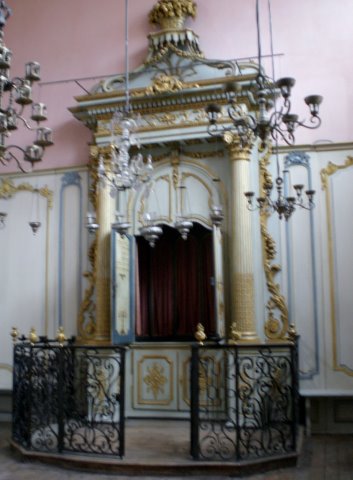
Jewish News

Cavaillon Synagogue: a glimpse into the lives of the ‘Pope’s Jews’
LORNA POPLAK
The synagogue is in the old town centre, sitting above an arched passageway at the northern end of a short cobbled street called the Rue Hébraïque. To reach it, you climb a flight of stone stairs onto a balcony. The inscription above the entrance to the synagogue reads: “This is the gate of the Lord into which the righteous shall enter” and the Hebrew date 5534, corresponding to 1774 CE, the year the building was completed.
Nothing so far prepares you for the marvel that greets your eye as you step into the high-ceilinged room.
The first surprise is the decor. It’s in the highly decorative Rococo style, with elegantly carved woodwork, delicate wrought-iron, graceful candelabra hanging from the ceilings, and a colour palette of pastel pink, blue, green, and lots and lots of gold.
There is a wrought-iron balcony supported by four wooden pillars on the west side of the room – not the women’s section, as you might expect, but the bimah. It was from here that the rabbi, sometimes surrounded by local dignitaries, presided over services.
On the east wall is the gilded ark with columns and intricately carved floral motifs. This odd setup meant that the congregation would have to turn away from the sacred Torah scrolls in the ark to face the rabbi.
Compounding the quirkiness of the layout is the small armchair perched high up in a corner of the room, hovering atop a puff of Rococo clouds. This is known as Elijah’s chair, and the prophet was asked to bless the circumcisions performed beneath it.
The main sanctuary on the upper floor was for men only; there was a separate room below for the women. This was also a bakery, and you can still see the old oven where matzot – called coudoles in Provençal – were baked. The women could hear the services through a tunnel in the oven.
The bakery is now the Comtadin Jewish museum. On display are a few manuscripts and other ritual objects. Among these relics is a poignant photograph of an old Jewish woman, wearing traditional Provençal dress, taken in the community in 1913.
Other than the synagogue and museum, the only buildings of significance to the history of Cavaillon Jews remaining on this street are an old house, where the last rabbi of the community lived, and the mediaeval mikvah.
The synagogue in Cavaillon was constructed not by Jews, but by local Provençal builders, which might explain some of its stylistic oddities. Jews had lived in the south of France from the time of Roman Gaul and enjoyed relative freedom until towards the end of the Middle Ages.
In the 1300s, however, they were banished and expelled from France. Many of them found sanctuary in Avignon, at that time ruled by the Vatican. Under the protection of a series of popes, they were allowed to live and work in Avignon and in the surrounding region, the Comtat Venaissin, as tradesmen and craftsmen.
These so-called “Pope’s Jews” were tailors and dyers, masons and woodworkers, even doctors and surgeons. Gradually their situation deteriorated, and by the 17th century they had lost most of their freedoms – their freedom to work, certainly. They were only allowed to work as secondhand clothing and furniture dealers, and as moneylenders.
Jews were also restricted in where they could live. The Rue Hébraïque, with the synagogue at one end, was Cavaillon’s old carrière. This term comes from the Provençal word carreira, which means street, but in the mediaeval context the word took on a darker meaning.
Jews were forced to live in these small streets, which, from the mid-15th century were gated at either end. The gates were locked at night, effectively creating ghettos. By the 18th century, more than 200 people were crammed into tottering tenements rising six or seven storeys high on either side of the Rue Hébraïque.
Life for the Jews in Provence improved greatly after the French Revolution of 1789. The carrières were abolished soon afterward, and Jews from the Papal territories were allowed to integrate into the wider French community.
So, which is the oldest synagogue in modern-day France? That honour goes to the synagogue in Carpentras, just a few kilometres to the north, with the Cavaillon Synagogue coming in a close second. As so few Jewish families now live in the area, the Cavaillon Synagogue is no longer used as a place of worship. For visitors, it’s a haunting window into the lives of the “Pope’s Jews” in old Provence.




